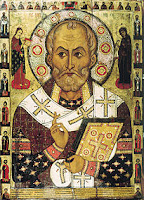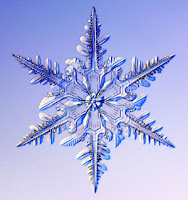Santa Claus Origins + Festivus Origins + Snowflake Sameness
 |
| St. Nicholas |
Part 1:
So, where did Santa Claus come from?
A lot of weird people think that the company Coca-cola invented Santa Claus for some reason. This is not true at all!
St. Nicholas was born in 280 AD, in Patara, a city of Lycia, in Asia Minor. He became the gift giver of Myra. His gifts were given late at night, so that the gift giver's identity would remain a secret. St Nicholas was eventually named the patron saint of children, sailors, Russia and Greece.
St. Nicholas was a Christian priest, who later became a bishop. He was a rich person, and traveled the country helping people, giving gifts of money and other presents. St. Nicholas did not like to be seen when he gave away presents, so the children of the day were told to go to sleep quickly or he would not come! Nothing has changed and Santa Claus will not arrive this Christmas unless the children go to sleep early. Another thing is that he has a sled pulled by a 8 legged horse. And, on Christmas Eve, it goes around and eats part of shoes from people and leave behind candy.
The name Santa Claus came from a mispronunciation from another language. So, the word Santa doesn't mean anything at all.
The person who started the modern day Christmas traditions was in the 17th century, when he wrote a poem about St. Nicholas coming: "Twas the night before Christmas". He named the reindeers, and the story about how he parks the sled on the roof.
But, Coco-cola did do something that effected the tradition! Back in the 1930s, color printing was really expensive. Coco-cola made the image of Santa Claus, no one knew what Santa looked like before. The red and everything about Santa was given by Coco-cola. That's why the modern day Santa looks completely different from the St. Nicholas.
Robert L. May created Rudolph in 1939 as an assignment for Montgomery Ward. And, it came out after Mickey Mouse, and somehow there was some plagiarism involved. So, now, there is a company that owns Rudolf the Reindeer. That's why you always see 8 reindeers instead of 9 in movies and pictures.
Part 2:
Festivus is a secular holiday celebrated on December 23.It wasn't known by anyone at all before the Seinfield episode. And, even when you look up for it online , you can't even really find anything about it.
This Festivus was actually made up by the writer 's Father of Seinfield. And, they celebrated it in February back in the 1970s. This was the only family that celebrated this tradition.
Instead of a Christmas tree, they have a pole instead.
At dinner, they don't spread happiness and the other stuff done at Christmas. They share with each other about the things that makes each other angry.
That's basically it.
 |
| Snowflakes |
Science Myth of the Week:
So, are all snowflakes patterns different?
The long answer is a bit more involved -- it depends on just what you mean by "alike," and on just what you mean by "snowflake." Let's look at the possibilities....
Nano-snowflakes can be exactly alike. Some things in Nature are exactly alike. For example, our understanding of elementary particles indicates that all electrons are exactly, precisely the same. This is one of the cornerstones of quantum physics, and if you think for a bit you will see that this is a profound statement. Electrons are true elementary particles, in that they have no component parts; thus they are all exactly alike.
A water molecule is considerably more complex than an electron, and not all water molecules are exactly alike. If we restrict ourselves to water molecules which contain two ordinary hydrogen atoms and one ordinary 16O atom, then again physics tells us that all such water molecules areexactly alike. However about one molecule out of every 5000 naturally occurring water molecules will contain an atom of deuterium in place of one of the hydrogens, and about one in 500 will contain an atom of 18O instead of the more common 16O. These rogues are not exactly the same as their more common cousins.
Since a typical small snow crystal might contain 1018 water molecules, we see that about 1015 of these molecules will be different from the rest. These unusual molecules will be randomly scattered throughout the snow crystal, giving it a unique design. The probability that two snow crystals would have exactly the same layout of these molecules is very, very, very small. Even with 1024 crystals per year, the odds of it happening within the lifetime of the Universe is indistinguishable from zero.
A water molecule is considerably more complex than an electron, and not all water molecules are exactly alike. If we restrict ourselves to water molecules which contain two ordinary hydrogen atoms and one ordinary 16O atom, then again physics tells us that all such water molecules areexactly alike. However about one molecule out of every 5000 naturally occurring water molecules will contain an atom of deuterium in place of one of the hydrogens, and about one in 500 will contain an atom of 18O instead of the more common 16O. These rogues are not exactly the same as their more common cousins.
Since a typical small snow crystal might contain 1018 water molecules, we see that about 1015 of these molecules will be different from the rest. These unusual molecules will be randomly scattered throughout the snow crystal, giving it a unique design. The probability that two snow crystals would have exactly the same layout of these molecules is very, very, very small. Even with 1024 crystals per year, the odds of it happening within the lifetime of the Universe is indistinguishable from zero.
Thus at some very pure level, no two snow crystals are exactly alike. An exception (why does there always have to be an exception?) would be a snow crystal with only a handful of molecules. If we assemble a crystal of only 10 molecules, for example, then it's not so unlikely that each of the 10 will contain two ordinary hydrogen atoms and one ordinary 16O atom. Furthermore, a cluster of only 10 molecules will only have a few likely configurations. So there's a reasonable probability that two 10-molecule snow crystals would be exactly alike.
I might add that even if we restrict ourselves to isotopically pure water molecules, it's still very, very unlikely that two macroscopic snow crystals would be exactly alike. When a crystal grows, the molecules do not stack together with perfect regularity, so a typical snow crystal contains a huge number of crystal dislocations, which again are scattered throughout the crystal in a random fashion. One can then argue, like with the isotopes, that the probability of two crystals growing with exactly the same pattern of dislocations is vanishingly small. Again one has the exception of few-molecule crystals, which can easily be free of dislocations.
I might add that even if we restrict ourselves to isotopically pure water molecules, it's still very, very unlikely that two macroscopic snow crystals would be exactly alike. When a crystal grows, the molecules do not stack together with perfect regularity, so a typical snow crystal contains a huge number of crystal dislocations, which again are scattered throughout the crystal in a random fashion. One can then argue, like with the isotopes, that the probability of two crystals growing with exactly the same pattern of dislocations is vanishingly small. Again one has the exception of few-molecule crystals, which can easily be free of dislocations.
Small snow crystals can look alike. Now let's relax our definition of alikeness, and say that two snow crystals are alike if they just look alike in an optical microscope (the smallest features one can see in an optical microscope are about one micrometer in size, which is about 10000 times larger than an atom). In this case things are very different. One can find simple hexagonal prisms falling from the sky, and one can certainly make such simple crystals in the lab. The picture here shows two such crystals grown using the free-fall method.
Crystals with simple shapes often look similar to one another, and it's not hard to imagine that if you sifted through a reasonable number of Antarctic snow crystals you would find two that were essentially indistinguishable in a microscope. Since simple crystals are very common (one doesn't notice them much because they're small), it's fair to say that there are a great many natural snow crystals that look pretty much alike.
But that's only for simple hexagonal prisms. What about more complex stellar crystals?
Crystals with simple shapes often look similar to one another, and it's not hard to imagine that if you sifted through a reasonable number of Antarctic snow crystals you would find two that were essentially indistinguishable in a microscope. Since simple crystals are very common (one doesn't notice them much because they're small), it's fair to say that there are a great many natural snow crystals that look pretty much alike.
But that's only for simple hexagonal prisms. What about more complex stellar crystals?
Larger, complex snowflakes are all different. The number of possible ways of making a complex snowflake is staggeringly large. To see just how much so, consider a simpler question -- how many ways can you arrange 15 books on your bookshelf? Well, there's 15 choices for the first book, 14 for the second, 13 for the third, etc. Multiply it out and there are over a trillion ways to arrange just 15 books. With a hundred books, the number of possible arrangements goes up to just under 10158 (that's a 1 followed by 158 zeros). That number is about 1070 times larger than the total number of atoms in the entire universe!
Now when you look at a complex snow crystal, you can often pick out a hundred separate features if you look closely. Since all those features could have grown differently, or ended up in slightly different places, the math is similar to that with the books. Thus the number of ways to make a complex snow crystal is absolutely huge.
And thus it's unlikely that any two complex snow crystals, out of all those made over the entire history of the planet, have ever looked completely alike.
Now when you look at a complex snow crystal, you can often pick out a hundred separate features if you look closely. Since all those features could have grown differently, or ended up in slightly different places, the math is similar to that with the books. Thus the number of ways to make a complex snow crystal is absolutely huge.
And thus it's unlikely that any two complex snow crystals, out of all those made over the entire history of the planet, have ever looked completely alike.
No comments:
Post a Comment